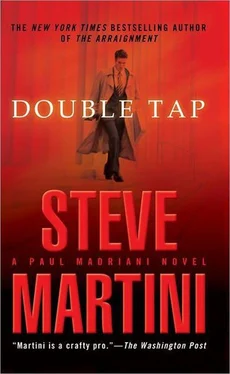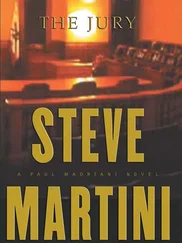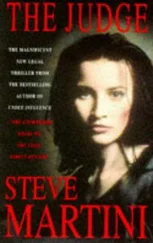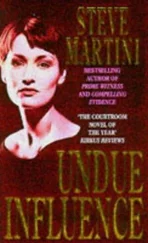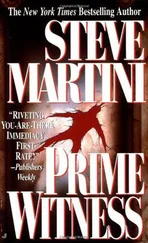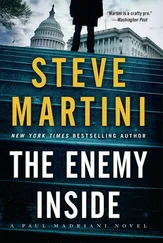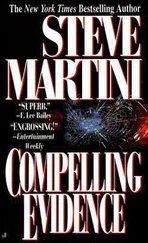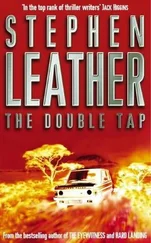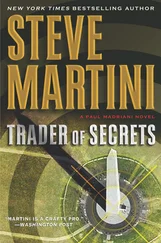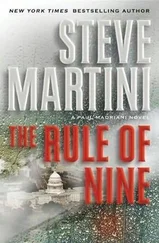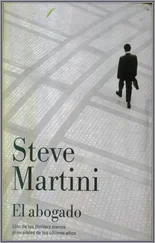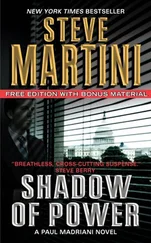Steve Martini - Double Tap
Здесь есть возможность читать онлайн «Steve Martini - Double Tap» весь текст электронной книги совершенно бесплатно (целиком полную версию без сокращений). В некоторых случаях можно слушать аудио, скачать через торрент в формате fb2 и присутствует краткое содержание. Год выпуска: 2014, ISBN: 2014, Издательство: Jove, Жанр: Триллер, на английском языке. Описание произведения, (предисловие) а так же отзывы посетителей доступны на портале библиотеки ЛибКат.
- Название:Double Tap
- Автор:
- Издательство:Jove
- Жанр:
- Год:2014
- ISBN:9781101550229
- Рейтинг книги:4 / 5. Голосов: 1
-
Избранное:Добавить в избранное
- Отзывы:
-
Ваша оценка:
- 80
- 1
- 2
- 3
- 4
- 5
Double Tap: краткое содержание, описание и аннотация
Предлагаем к чтению аннотацию, описание, краткое содержание или предисловие (зависит от того, что написал сам автор книги «Double Tap»). Если вы не нашли необходимую информацию о книге — напишите в комментариях, мы постараемся отыскать её.
Double Tap — читать онлайн бесплатно полную книгу (весь текст) целиком
Ниже представлен текст книги, разбитый по страницам. Система сохранения места последней прочитанной страницы, позволяет с удобством читать онлайн бесплатно книгу «Double Tap», без необходимости каждый раз заново искать на чём Вы остановились. Поставьте закладку, и сможете в любой момент перейти на страницу, на которой закончили чтение.
Интервал:
Закладка:
“Yes, I have seen such situations,” says Perryman.
With a crayon, Templeton draws a picture of the obvious for the jury.
“Even an item of evidence that might have substantial monetary value?” Templeton asks.
“Yes. I have seen and am familiar with cases in which expensive evidence has been disposed of because it might link a suspect to a crime.”
Obvious as it may be, it is nonetheless effective. In closing, he can now argue that theft of the Orb was never the motive for the murder: that Ruiz took it no doubt to throw the cops off his scent to make it look like Chapman’s murder was a killing during the course of robbery. The state will argue that after the murder Ruiz had to get rid of it, since the art glass would have linked him beyond question to the homicide.
“During the course of your investigation, you were inside the victim’s house for a considerable period of time, were you not?” says Templeton.
“That’s correct.”
“And during that time, did you have an opportunity to observe and to inventory all of the items of expensive artwork that were present there?”
“I did.”
During the course of your investigation, did you determine whether any other items of glass art were missing from the victim’s residence besides the item known as the Orb at the Edge ?”
“We were able to determine that there were no other missing items. The victim maintained a very active and up-to-date schedule of insurance on the items displayed in her home. She had a separate schedule for the items at her office. All of the items listed were still present following her death.”
“Except for the Orb at the Edge ,” says Templeton.
“Correct.”
“Was that insured?”
“No. We knew about that only because we found the bill of sale and the merchant who sold it to her.”
Templeton makes the point: if the purpose was burglary or robbery why didn’t the killer take any of the other objects of glass? Even in haste he would have grabbed one or two of the more expensive-looking items to go along with the Orb . But he didn’t.
Harry and I blow through lunch at Mac’s.
“Whoever did it was either awfully lucky or had some insights,” says Harry. He is talking with his mouth full of barbecue beef, one corner of a large paper napkin tucked over the knot of his tie. Harry is hunkered over his plate, allowing the excess to drip down onto the plate.
“If I had to guess”-I poke around at my salad as I’m thinking-“somebody who’s spent enough time in court or has enough knowledge of investigative techniques to make everything point in the wrong direction,” I tell him.
Harry stops chewing just long enough to look up at me. “You have a candidate in mind?”
“I don’t know. I’m thinking about it.”
In the afternoon I get my shot at Perryman on cross.
“You say you found no spent cartridges at the scene, is that correct?”
“That’s right.”
“That would mean that the killer must have taken the time to pick them up?”
“I don’t know,” says Perryman. “I can’t answer that question.”
“We are talking about a semiautomatic handgun here, are we not? The pistol you say police found in Madelyn Chapman’s backyard?”
“Yes. It’s semiautomatic.”
“That means each time it fires a separate shot, it ejects the empty cartridge from the gun, does it not?”
“Objection,” says Templeton. “The witness is not qualified as a firearms expert.”
“But he has found firearms at the scenes of numerous homicides, along with expended cartridge cases,” I say.
“I’ll allow the witness to answer the question if he knows the answer,” says Gilcrest.
“A semiautomatic handgun would normally eject an expended cartridge each time it’s fired,” says Perryman.
“Thank you. That means, assuming the state’s evidence is correct, you would expect to find at least two expended cartridges at the scene, is that right?”
“I suppose.”
“But you didn’t.”
“No.”
“So someone must have taken them.”
“I presume so.”
“Why would someone who had just murdered a woman-shot her twice with a handgun-stop to pick up expended cartridge cases?”
“Maybe they didn’t want us to be able to trace the cartridges back to the handgun,” says Perryman. “Tool marks,” he adds.
“But they left the handgun for you to find. Does that make sense?”
“That’s not true,” says Perryman. “From what we were able to deduce, the killer tried to throw the handgun over the wall in the backyard.”
“Ah. He tried to hit the ocean but he missed?”
This is their theory. Perryman doesn’t like the way I’ve put the question, so he doesn’t answer it. I ask it again.
“How could he-or she, for that matter-miss the ocean?”
“He didn’t throw it hard enough,” says the witness. “It probably hit the wall and bounced back into the yard.”
“Ah. I see. Your Honor, if I might. .” I want Gilcrest to allow me to examine the firearm.
The judge nods.
This allows me a little freedom to move away from the podium and around the courtroom. I move to the table in front of the jury box and pick up the pistol. I smile at several of the jurors. Only one of them smiles back.
The slide of the pistol has been wired back, the chamber held open by a nylon cable tie so that it cannot be loaded without removing this: the standard safety precaution in most courtrooms and many private gun shops.
I turn toward the witness. “It’s heavy.”
He nods.
“Do you have any idea what it weighs?”
“If I could look at my notes. .” he says.
“I have no objection.” I look at Templeton sitting on the box on his chair.
He shrugs a shoulder. “No objection,” he says.
Perryman rifles through a few pages until he finds the one he’s looking for. “According to the manufacturer, the handgun without a loaded clip weighs two point four two pounds.”
“So it would take a pretty good throw to make it to the ocean from the backyard of Ms. Chapman’s house.”
“My point exactly,” he says.
“Hmm. Can you show me where it hit?”
“Excuse me?” he says.
“Where this handgun hit the wall in the backyard. You say you believe that the killer threw the gun from the backyard but that it probably struck the wall and bounced back into the yard. That is what you just said. So, can you show me the marks on the gun where it hit the wall?”
Perryman is beginning to look a little uncomfortable in the witness box.
“That’s just one possible theory,” he says.
“Yes. Well. If I hand you the gun, can you show me what part of it struck the wall? May I approach the witness, Your Honor?”
Gilcrest waves me on.
I hand Perryman the gun.
He takes it like it’s some foreign object, not knowing which end is supposed to be up. He checks the handle first. It is pristine, as is the blued metal on the barrel, both sides, and the top of the slide.
“I can’t say,” he says.
“You don’t find any dents or scratches that might be consistent with the gun hitting the wall?”
He looks again. “There’s a little wear on the barrel near the crown. The bluing is off,” he says.
“But hitting the wall wouldn’t cause wear, would it?”
“No. Probably not.”
“Do you see any major nicks or dents?” I ask.
“No.”
“Do you remember what the wall behind Madelyn Chapman’s house is made of?” I ask.
He looks at me, not sure what to say or whether he should guess.
“What if I told you it was made of concrete cinder blocks covered with stucco? What would you say?”
Читать дальшеИнтервал:
Закладка:
Похожие книги на «Double Tap»
Представляем Вашему вниманию похожие книги на «Double Tap» списком для выбора. Мы отобрали схожую по названию и смыслу литературу в надежде предоставить читателям больше вариантов отыскать новые, интересные, ещё непрочитанные произведения.
Обсуждение, отзывы о книге «Double Tap» и просто собственные мнения читателей. Оставьте ваши комментарии, напишите, что Вы думаете о произведении, его смысле или главных героях. Укажите что конкретно понравилось, а что нет, и почему Вы так считаете.
